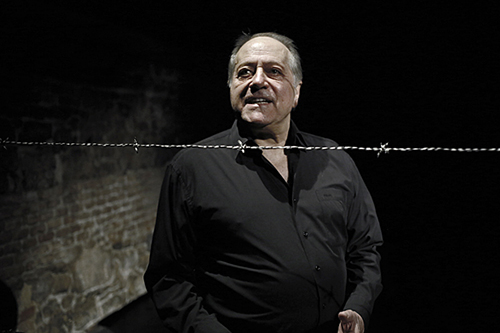It’s always there, stretched across the stage. For the entire 70 minutes of The Good and the True, a play based on the recollections of Holocaust survivors Hana Pravda and Milos Dobry, barbed wire hangs between us and the actors. Even after the characters survive Auschwitz and death marches, the wire is there. Even when they go on to have families and celebrated careers—Dobry was a rugby star and Pravda a renowned actress—the barrier stays in place.
“We’re standing there with it an inch away from our faces,” says Saul Reichlin, who plays Dobry. “It’s very powerful as something for an actor to work behind.”
But here’s the thing: Eventually, audiences at the DR2 Theatre, where The Good and the True will play through mid-September, may stop noticing the fence is even there. After all, we’re experiencing a fascinating story about people who survived a nightmare and went on to thrive. Milos and Hana’s humanity pushes past the wire. (Which is really just string, by the way. It’s part of the set design by Daniel Hrbek, who also directs and helped compile Milos and Hana’s testimonies.)
The actors have the same response. “You get so used to it that you stop noticing it after a while unless you’re standing right up close to it,” says Reichlin, speaking during a recent phone call. “You get used to the dangers of life. They just become facts.”
At that, Reichlin’s co-star, Isobel Pravda, interjects: “I think that’s an excellent point, and I think you can make it even wider. These two people lived with the fact of the Holocaust. Not that they ever accepted it as being okay, but they got on with things. They lost their families and continued to live and love and live again.”
Isobel can speak about her character’s mindset with rare certainty, since Hana Pravda was her real-life grandmother.
“When my grandmother spoke about it, she would talk about the funny incidents, the things that made her laugh in Auschwitz,” she recalls. “And even when she did talk about the horrible things, it was just as a fact. She lived through it and survived it, and it was part of her life. For other people, it might be shocking in the hearing, but it was something she lived with.”
So perhaps the barbed wire is more of a passive presence than a constant threat. Naturally, once you survive what Milos and Hana survived, you can’t unwind it from your life. But if the play is any indication, perhaps you can see around it. Perhaps you can carry on living and even living well, without forever being gouged by your past.
Mark Blankenship is TDF’s online content editor
Photos courtesy of Svandovo Divadlo
